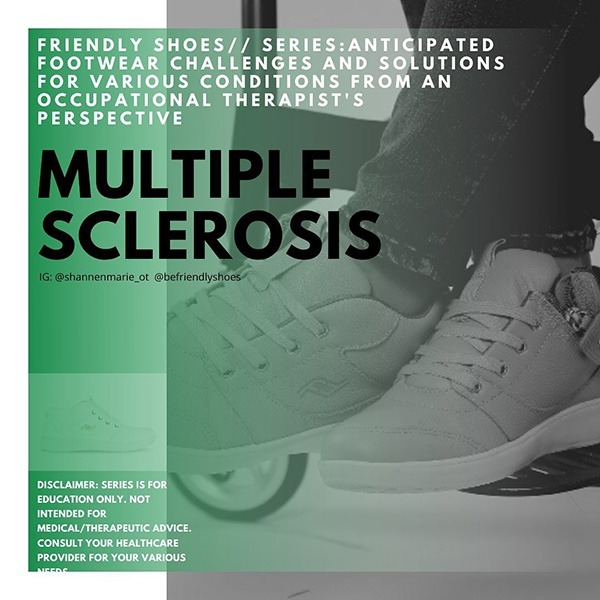Multiple Sclerosis (MS) Footwear Challenges
What is multiple sclerosis (MS)?
A disease that affects the neural transmission (communication) within the central nervous system (CNS). People are typically diagnosed between ages 20-50 although its onset can occur at any age.
Symptoms can include: fatigue, numbness, tingling, decreased fine/gross motor function, reduced balance, reduced memory/cognitive abilities
*AFO braces are often recommended if general weakness occurs in the ankle joint
Daily Task Barriers:
Daily tasks often become difficult due to the above symptoms, especially putting on/taking off shoes.
Depending on the severity of the neurologic damage, individuals with MS can have completely different scenarios/prognoses. This is why early detection is so important as it can reduce the amount of damage.
Assuming an individual identifies the neurologic condition early, they may only encounter minor symptoms. This is why early detection and working with a trusted healthcare professional on an ongoing basis is of the utmost importance.
‘MS has many faces and it affects people in many different ways’ per Dr. Glenn B. Pfeffer, MD.
Although each case of MS may manifest differently, it can be beneficial to put the disease into the following categories:
Active- time that includes attacks and evidence the condition is worsening
Not-active- condition stability, no evidence of worsening changes
Worsening- a notable worsening of the condition following a relapse
Not-worsening- the person experienced a relapse but no changes noted
Friendly Footwear Solutions by Dr. Glenn B. Pfeffer, MD director of the Foot and Ankle Program at the Cedars-Sinai Orthopaedic Center and a spokesman for the American Academy of Orthopaedic Surgeons
Shoot for comfort, and proper fit:
Comfort needs to be paramount, even above fashion. The shoe has to fit not only the person’s foot but also the person’s specific needs. You can still look for styles you like but consider shoes that are comfortable right away
Test the Tread:
Like a car sliding our feet can slide out from underneath us, especially if balance impairment is present.
Test out your shoe outsole tread, look for rubber bottoms. Going barefoot or slip-ons is associated with a higher risk of falls, so wear shoes with firm, slip-resistant soles both inside and outside your home.
Avoid smooth, slippery, leather soles and overly soft soles on slippers.
Shoe soles to meet wearers needs:
Shoe soles are like mattresses, they come in ranges from firm/thick to flexible/thin. Each shoe sole technology has different benefits for different footwear challenges. Ie. plantar fasciitis, ankle weakness, bunions, decreased endurance
Per Dr. Pfeffer, “If someone is having sensory loss, they often complain of not being able to feel the ground well,” Pfeffer says. “They may want to have a thinner-soled shoe so they can have a better sense of feedback.”
Conversely, if someone has other conditions or footwear-related issues such as plantar fasciitis it may be in their best interest to select shoes on the more firm/thick side of the spectrum.
Check shoe weight and flexibility:
Consider the weight of clunky thick shoes as this can reduce daily endurance/limit walking distances. On the other hand, shoes that are too flexible can reduce stability on your feet if there is a balance impairment.
*Remember, people who have had a recent fall are at the highest risk of falling. Visit www.Friendlyshoes.com for tips on how to help reduce the risk of falls.
Skip high heels and slip-ons:
Dr. Pfeffer recommends shoes with heel heights less than 2 inches. He recommends avoiding any shoes that are backless, such as slip-ons, or that could slip off your heel.
Flip-flops are a definite no-no. “All of those shoes need a good sense of sensory feedback and toe strength to stay on,” Pfeffer says. “They become a danger because they can just fly off, and they add very little support.”
Opt for easy:
Shoes with laces are the best for preventing the foot from sliding within the shoe if you are able to do it. If not, consider velcro or adaptive shoes. Consider elastic laces.







